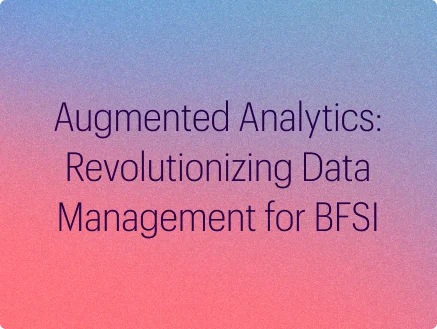Data is meant to drive impactful business outcomes, directly influencing revenue and growth. Yet, in the relentless pursuit of data modernization, many organizations find themselves stuck in a cycle of inefficiency—processing vast amounts of data without translating it into actionable insights. This challenge is magnified by shifting leadership priorities and constantly adding new platforms to complex enterprise stacks. The key question is whether the focus is on the right data to generate business value. In realistic terms, instead of measuring success by the volume of data processed, the focus must shift to how much of that data is truly utilized to drive outcomes.
The role of data has evolved from being a by-product of operations to becoming a core asset for decision-making, innovation, and customer experience. To fully realize its potential, organizations must embrace a data product mindset, emphasizing data as a product with measurable value, clear ownership, and user-centric design. Treating data as a product ensures that data is not merely collected but effectively leveraged to deliver tangible business outcomes.
Key Pillars of a Data Product Mindset
- Measurable Value: Success metrics should be tied directly to business outcomes. For example, increased customer retention can be measured through Net Promoter Score (NPS) or churn rate. Operational efficiency could be evaluated through reduced time to insight or cost savings.
- Clear Ownership: It is crucial to assign product owners for data. They are accountable for data quality, accessibility, and lifecycle management. Clearly defining roles and responsibilities fosters better collaboration and governance.
- User-Centric Design: Data products must meet the needs of their consumers. A Customer 360 (C360) data product could mean providing marketing teams with dashboards for segmentation and offering real-time insights to customer service agents for personalized interactions.
Example Use Case: Retailer’s Data Product Strategy
For a large retailer, transitioning to a data product mindset means enabling better decision-making across the organization through well-defined data products. Here’s how this transformation can be structured:
Business Decisions to Enable
- Personalized Marketing: Use customer segmentation and predictive models to tailor promotions and increase customer lifetime value.
- Inventory Optimization: Leverage real-time sales data to ensure optimal stock levels, reducing excess inventory and preventing stockouts.
- Pricing Strategy: Implement dynamic pricing models based on demand trends, competitor pricing, and customer behavior.
- Supply Chain Efficiency: Improve delivery times and reduce costs using data-driven route optimization and demand forecasting.
- Store Operations: Enhance in-store experiences through better staff allocation and product placement based on foot traffic patterns.
Domains and Subdomains
To support these decisions, the retailer can define the following domains and subdomains:
- Marketing Domain: Customer Segmentation, Campaign Performance Analytics, Customer Lifetime Value Prediction
- Sales Domain: Point-of-Sale Data Analysis, Cross-Channel Sales Performance, Revenue Forecasting
- Inventory Domain: Stock Level Monitoring, Inventory Turnover Analysis, Demand Forecasting
- Supply Chain Domain: Supplier Performance Analytics, Delivery Route Optimization, Logistics Cost Analysis
- Operations Domain: In-Store Analytics, Staff Allocation Optimization, Customer Experience Metrics
Team Organization
To implement this strategy, the retailer can structure teams around key domains:
Cross-Functional Domain Teams:
- Each domain team should include data engineers, data scientists, product managers, and business analysts.
- These teams deliver data products that drive measurable outcomes within their respective domains.
Centralized Data Platform Team
- This team provides the foundational data infrastructure, including data lakes, pipelines, and governance frameworks.
- It ensures data accessibility, scalability, and compliance across all domains.
Data Governance Team:
- This team defines and enforces data standards, ensuring consistent data quality and security.
- It collaborates with domain teams to maintain a federated governance model.
Product Management Team:
- Product managers are embedded within each domain team to prioritize work, gather requirements, and align efforts with business goals.
Transitioning to a Data Product Mindset: C360 Implementation in Databricks
To demonstrate our approach, consider the implementation of a Customer 360 (C360) data product using Databricks. The goal was to create a unified view of the customer by integrating data from multiple sources, including CRM systems, transactional databases, and marketing platforms.
Steps Taken:
Data Ingestion and Integration:
- Leveraged Databricks’ Delta Lake for seamless ingestion of structured and semi-structured data.
- Integrated real-time data streams using Apache Kafka to ensure up-to-date information for time-sensitive use cases.
Data Processing and Transformation:
- Built scalable ETL pipelines using Databricks notebooks to cleanse, enrich, and transform raw data into a consolidated customer profile.
- Automated complex transformations, such as deduplication and entity resolution, to maintain high data quality.
Advanced Analytics and Machine Learning:
- Enabled data scientists to build machine learning models for segmentation, churn prediction, and personalized recommendations.
- Integrated these models into the C360 product, enabling targeted marketing campaigns, which led to a 10-11% increase in website traffic and a 3-4% improvement in Return on Ad Spend (ROAS).
User-Centric Delivery:
- Developed dashboards and APIs for marketing teams to track campaign performance in real-time and for customer service agents to access personalized insights.
Governance and Monitoring:
- Implemented role-based access controls and data lineage tracking using Databricks’ Unity Catalog to ensure governance and compliance.
Leveraging Existing Structure for the Data Product Shift
At MathCo, we transition our customers to a data product mindset by leveraging existing organizational structures and aligning them toward domain-driven teams. Rather than dismantling established teams, we reorganize them around key domains such as marketing, customer support, sales, etc.
- Cross-Functional Teams: Each domain-specific team consists of data engineers, data scientists, and analysts who collaborate toward shared business outcomes.
- Product Ownership: Clear ownership assigned within each team ensures accountability for data products.
- Outcome-Focused Collaboration: We foster a culture focused on value delivery by aligning teams toward measurable business outcomes, such as increased ROAS and improved customer engagement.
This approach allows us to maintain role specialization while aligning efforts with domain goals, leading to high-impact solutions with minimal disruption.
Challenges in Transitioning to a Data Product Mindset
Despite the benefits, transitioning to a data product mindset presents several challenges:
- Team Alignment: Aligning cross-functional teams to work toward shared outcomes can be difficult. Traditional roles often focus on isolated tasks like pipeline optimization or model accuracy. A shift toward collaborative, outcome-driven work requires clear communication and training.
- Cultural Shift: It is crucial to change the perception of data from a technical asset to a strategic enabler. This involves fostering a culture of collaboration and shared responsibility.
- Governance Complexity: With multiple teams contributing to shared data products, governance becomes complex. Ensuring data quality, access control, and compliance across domains requires robust frameworks and federated governance models.
- Outcome Prioritization: Prioritizing business outcomes over technical processes can create friction. Establishing clear KPIs and aligning incentives to those outcomes help overcome this challenge.
- Technology Integration: Leveraging existing platforms while adopting a product mindset requires careful planning to avoid disruptions.
Evolving Metrics for Success
Traditional metrics, such as the volume of data processed, are insufficient. Organizations must adopt metrics that directly reflect business outcomes and user satisfaction:
- Customer Engagement Metrics: NPS, churn rate, and cross-channel purchasing behavior.
- Operational Efficiency: Time-to-insight and data pipeline reliability.
- Revenue Impact: ROAS, conversion rates, and upsell success.
- Adoption and Usage: User adoption rates and frequency of data product usage.
These metrics ensure alignment between data initiatives and strategic goals.
Changing Role of Data Engineers
In the data product paradigm, the role of data engineers evolves:
- Value-Driven Development: Data engineers collaborate with product managers to design pipelines that support measurable outcomes.
- Cross-Functional Collaboration: They work alongside data scientists and analysts to build data products that meet user needs.
- Ownership and Accountability: Data engineers take ownership of data quality and performance.
- Innovation: They leverage advanced tools for real-time processing, automated monitoring, and self-healing pipelines.
Conclusion
Adopting a data product mindset is a transformative journey. It shifts the focus from process-driven approaches to value-driven outcomes, emphasizing collaboration, ownership, and continuous improvement. While challenges like team alignment, cultural shifts, and governance complexities exist, they can be addressed through clear strategies, strong leadership, and appropriate accelerators.
Ultimately, transitioning to a data product mindset empowers organizations to unlock the full potential of their data assets, transforming them from being data-rich but insight-poor into truly data-driven enterprises that consistently deliver measurable business value.



